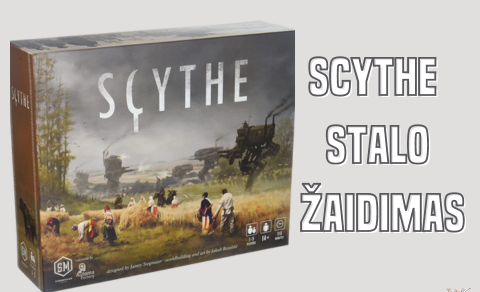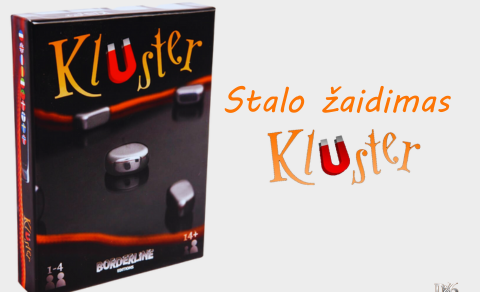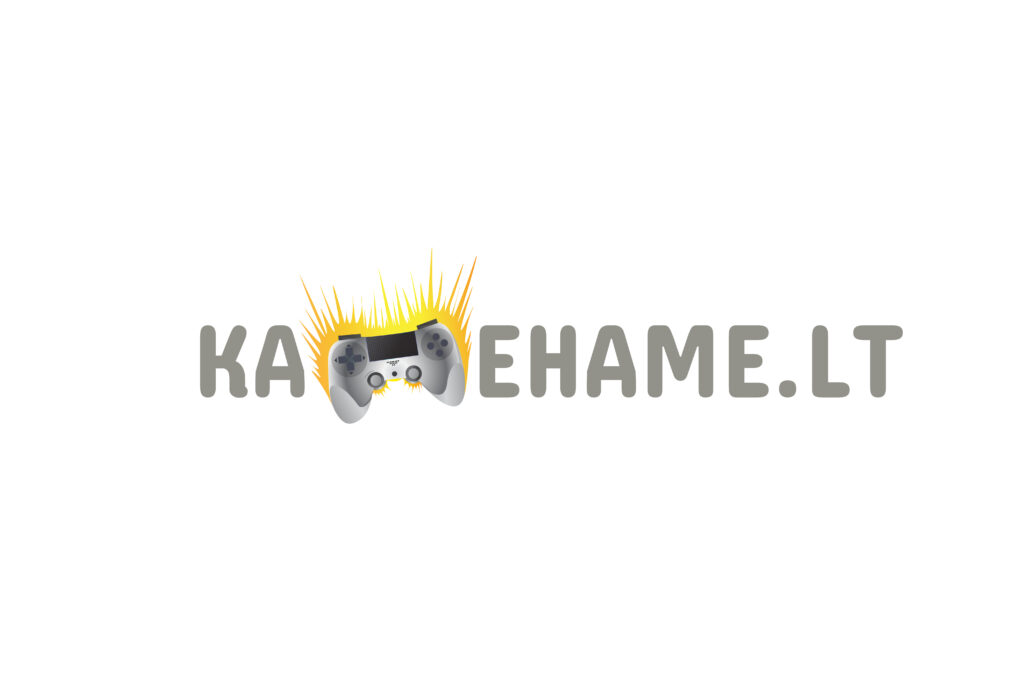Pandemic is completely different from the rest of our usual board games. It's not a case of fighting against each other, but of all players joining forces to fight against the game itself. Pandemic was first introduced to the public in 2008.

Other team board games
Do you like activities where you are not personally involved with other team members? Then you can try other collaborative games too.
Alias - one of the most popular and oldest word guessing games. You split into teams, draw cards, interpret the words on them and... hope your teammates guess. In Alias Party, you'll not only be interpreting the words, but you'll also have to act, do squats, simulate certain emotions or create stories. A good time guaranteed!
Let's bet. Party version - this game is a bit different from Alias. Here you have to collect money for completing tasks. How to do it? You have to act out certain situations, perform other tasks on the cards, or bet on whose dice will roll more eyes. The other players will bet on whether you will be able to complete the given tasks. Just remember to bet responsibly, otherwise you could lose your money and lose the game quite quickly.
Pandemic rules and game description
Play Pandemic and you become part of the team at the Centre for Infectious Disease Control. You'll have to work together to invent vaccines in time to stop outbreaks. Otherwise, four deadly diseases (Blue, Black, Red and Yellow) could kill the whole human race.
The aim of the game is to invent vaccines against four deadly diseases.
Each team member has specific abilities that increase the chances of winning the game.
Unfortunately, it is also possible to lose. Pandemic is a losing game if:
- The world is in a state of global panic following the eighth outbreak of the epidemic;
- a player has to place a disease cube on the game board, but there are no more cubes (the disease has spread);
- the player has to pick up the card, but has run out of cards (the time allowed for the game has expired).

Preparing for Pandemic
The game set includes:
- 7 character cards;
- 7 figures;
- 59 Pandemic game cards (48 cities, 6 epidemics, 5 events);
- 4 memory cards;
- 48 infection cards;
- 96 disease cubes (24 of each of the four colours);
- 4 vaccine markers;
- 1 marker of infection level;
- 1 epidemic outbreak marker;
- 6 research stations;
- 1 game board.
Frequently asked questions
❓ How many people can play Pandemic?
According to the Pandemic rules, you can play from 2 to 4 people.
❓ How old can I play Pandemic?
Pandemic adapted for gamers from 8 years old.
❓ How long does it take to play a Pandemic game?
Mostly played around 45 minutes. Additional 10 minutes take time to prepare for the game.
Preparation for the game
1. Game board and disease cubes
The board shall be placed in a place easily accessible to all. The disease cubes are sorted into four groups according to colour and placed next to the board. One research station figure is placed on the board in the city of Atlanta and the others are placed next to the board. You will need them later.
2. Epidemic outbreaks and vaccine markers
Place an epidemic outbreak marker in the epidemic outbreak indicator box (marked with a number "0"). Place the four vaccine markers next to the game board, near the invented vaccine indicator. Place the "ampoule" side up.
3. Spreading the infection in nine cities and placing an infection level marker
The infection level marker is placed on the first box of the indicator marked with a 2. Shuffle the infection cards and open 3 of them. The cards show the cities and colours indicated. Place 3 disease cubes (of the same colour as the infection cards) in each of these cities. Open 3 more cards. Place 2 disease cubes in each of the indicated cities. Open the 3 cards again and place 1 disease cube in each of the corresponding cities. Place the used cards face up in the stack of used infection cards at the top of the game board. Place the remaining cards face down in the indicated place on the game board (next to the used cards).
4. Handing out cards and figurines
Each player receives 1 memory card. Shuffle the character cards and give each player 1. All players then take 1 piece of the colour indicated on their character card. The rest of the cards and pieces do not take part in the game.
Shuffle the city and event cards (no epidemic cards) and distribute them to the players according to the number of players:
- When playing 2, each player receives 4 cards;
- if 3 are playing, they get 3 cards each;
- If 4 are playing, they get 2 cards each.
5. Preparation of the deck of playing cards
The number of epidemic cards we leave in the game is based on the difficulty of the game.
4 cards are for the familiar game, 5 cards are for the normal game, and 6 cards are for the hero game. Unwanted cards are not part of the game.
Divide the remaining playing cards into as many equal piles as possible, equal to the number of epidemic cards we have left. In each face-down pile, we add one face-down epidemic card. Finally, stack the piles on top of each other (if there are smaller piles, then place them on the bottom) to form a single pile of cards.
6. Pandemic game starts
Players look at their city cards. The first move is made by the player whose city has the highest population.
Pandemic is played as follows
During each walk:
- 4 steps
- 2 playing cards are taken
- spreading infection in cities.
When one player spreads his infection in the cities, the player to his left plays. Players can confer, express their opinions, develop strategies, but the final word goes to the player whose turn it is at the time. Cities and event cards may be held in the hand. The difference between the cards is that cities can only be used for certain actions, while events can be used at any time.
Actions
No more than 4 actions (any of the following) may be performed per turn.
1 action point per action. The special abilities of an existing character can change the way an action is performed. Some actions require the use of one of the cards in your hand. Used cards are placed in the used cards pile.
Actions for moving figures:
 Travel by car or train
Travel by car or train
You move your piece to a nearby city. It is connected to the current city by a white line
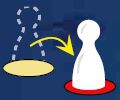 Direct flight
Direct flight
You can go to any city on your existing city cards. Before you move, the card for that city is placed in the used card pile
 Charter flight
Charter flight
If you are in a city where you have a card, you can move to any city you want. Before moving, the card of the city you are in must be placed in the used card pile.
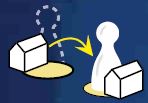 Regular flight
Regular flight
If the figurine is in a city with a research station, you can move it to any other city with a research station.
Other actions
 Construction of a research station
Construction of a research station
You can build a research station in the city where you have your card. Before it is built, the card for that city is placed in the used card pile. The Research Station piece must be taken from the pile next to the game board. If all the Research Stations are already on the board, then any of them can be picked up and moved.
 Disease treatment
Disease treatment
If you wish, you can remove 1 disease cube from the city you are standing on. The cube is placed in the pile of cubes next to the game board. If a vaccine has been invented for this disease, then all cubes of this colour can be removed from the city. For more information on vaccines see "The invention of the vaccine".
When the last cube of a disease for which a vaccine has already been invented is removed from the game board, the disease is cured. The disease marker is then inverted from the ampoule to the ![]() face up.
face up.
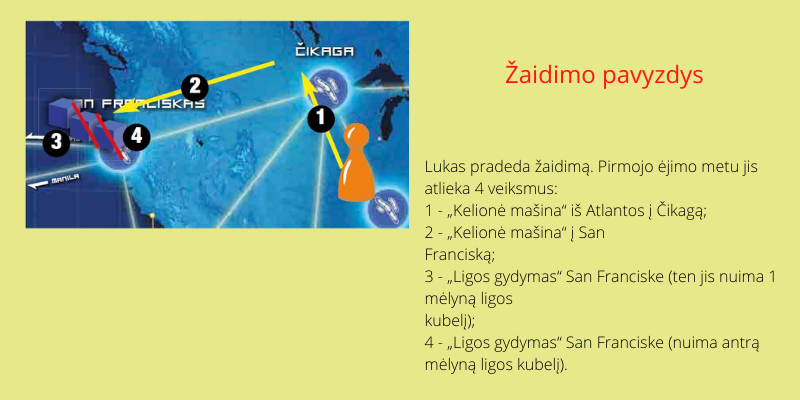
 Sharing knowledge
Sharing knowledge
There are two ways to do this: to another player by giving or from it Available from the city card where your pieces stand. This action needs to be agreed between you. It is important that both players must be standing on this city. If any player has more than 7 cards after this action, then 1 card must be placed in the used card pile or the event card must be used. For more information on event cards see "Event cards„
 The invention of the vaccine
The invention of the vaccine
When the figure stands in a research centre, a vaccine for a disease can be invented. In this case, 5 city cards of the same colour as the disease for which the vaccine is being developed should be placed in a pile of used cards. Once a vaccine has been invented, the marker for that disease is placed on the vaccine indicator box of the corresponding colour on the game board.
If there are no more cubes of this colour on the board, the disease is cured. The disease marker is then inverted from the ampoule to the ![]() face up.
face up.
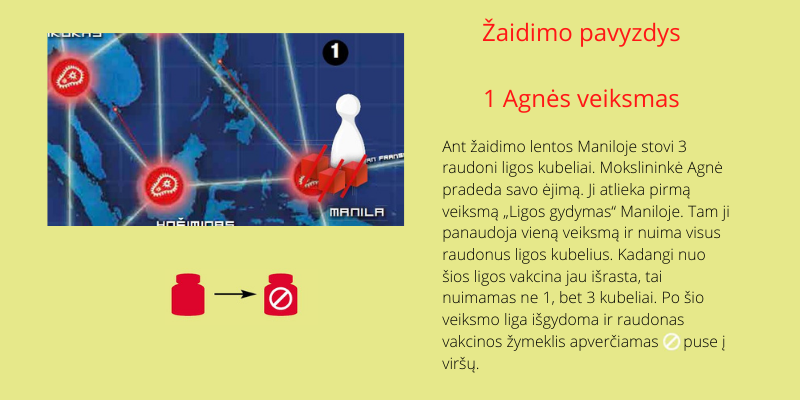
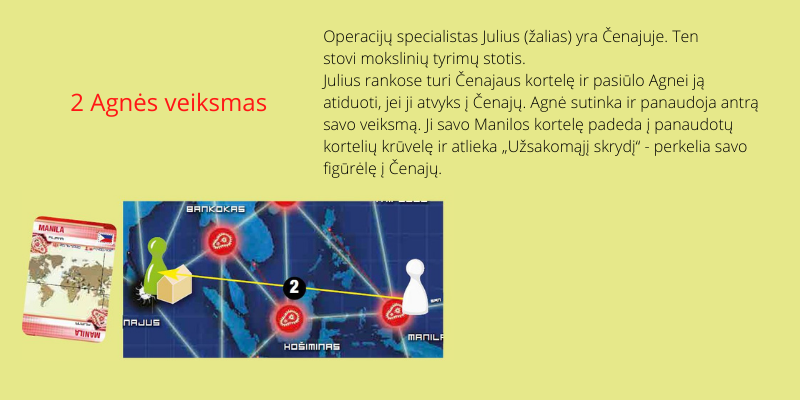
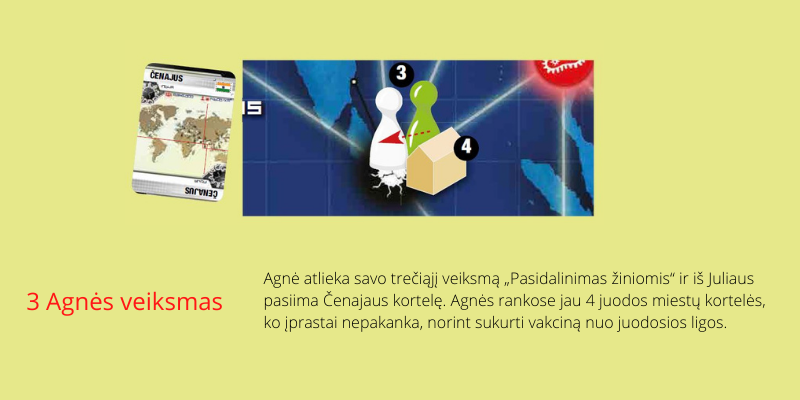
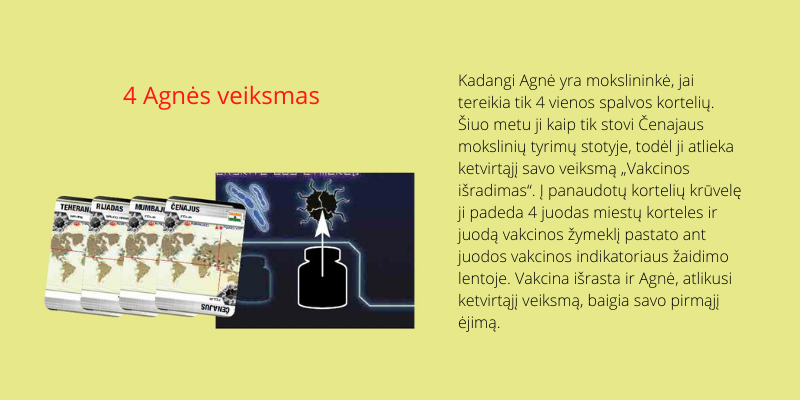
Card pick-up
After 4 actions during your turn, you must take the top 2 cards from the playing card pile.
![]() If there are not enough cards left, the game ends and all players lose. Used cards cannot be used a second time!
If there are not enough cards left, the game ends and all players lose. Used cards cannot be used a second time!
Epidemic cards
When an Epidemic card is taken from the pack of playing cards, the following steps must be taken immediately:
1. Increase infection level - in the infection level indicator, move the infection level marker forward by 1 cell;
2. Spread the epidemic - take the bottom card from the pile of infection cards. If a disease of this colour has not yet been cured, then 3 disease cubes of the corresponding colour should be placed on the city indicated on the card. If there are already disease cubes of this colour in this city, then only enough disease cubes of this colour need to be placed so that the total number of disease cubes of this colour is 3. If a city has 3 disease cubes of the same colour, then it is in an epidemic. The used infection card is placed in the pile of used infection cards.
![]() If disease cubes of a particular colour are to be placed on the game board and there are no more disease cubes, the game is over and all players lose. This happens not only during the spread of an epidemic, but also during the outbreak of an epidemic or the spread of an infection.
If disease cubes of a particular colour are to be placed on the game board and there are no more disease cubes, the game is over and all players lose. This happens not only during the spread of an epidemic, but also during the outbreak of an epidemic or the spread of an infection.
3. Increase the intensity of the infection - only used infection cards are taken, mixed and placed face down on top of the pile of infection cards. Used infection cards should not be mixed with unused ones. They should be placed on top of the unused infection cards.
If you pick up 2 epidemic cards at the same time, then you need to complete the actions on one epidemic card first and then move on to the second epidemic card once you have completed them.
Once used, epidemic cards must be placed in the game box and never used again.
Pandemic sets the maximum number of cards that can be held in a hand
A maximum of 7 cards can be held in the hand. Sometimes more than 7 cards are left in your hand after you have taken the cards and performed the actions associated with the epidemic cards. In this case, the unwanted cards should be placed in the used game card pile or the event cards should be used in such a way that only 7 cards remain in the hand. For more information on Event Cards, see "Event cards„
Spread of infection
The number of cards taken from the infection card pile is equal to the number indicated by the infection level marker. This number shall be indicated below the infection level indicator field on which the infection level marker is placed. The cards shall be turned over one at a time and the infection shall be spread immediately in the city indicated on the card.
The infection is spread in a city by placing a disease cube of the corresponding colour on the designated city. If the disease has already been cured, the cube does not need to be placed. If 3 cubes of this colour are already placed in the indicated city, an epidemic outbreak of the disease begins. A fourth cube does not need to be placed. Once the infection card has been used, place it in the pile of used infection cards.
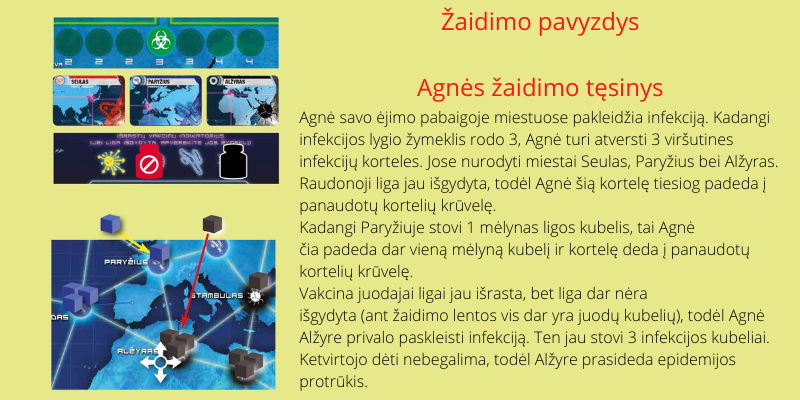
Epidemic outbreaks
When epidemic outbreaks occur, the epidemic outbreak marker is moved 1 field forward in the epidemic outbreak indicator. In the towns (connected) around the affected town, 1 cube of the disease is added. If there are already 3 cubes of the disease in a city, then the fourth cube is not added because a chain reaction occurs and a second outbreak starts.
During the second outbreak (and each time an outbreak occurs), the outbreak marker is moved forward again by 1 field. Then, in the cities connected to the city where the outbreak occurred, we place 1 disease cube. We only exclude cubes in cities where an outbreak has already occurred during the actions related to the current infection card.
Epidemic outbreaks can result in cubes of different colours in the city, with a maximum of 3 per colour.
![]() When the outbreak marker reaches the last outbreak indicator box, the game ends and all players lose.
When the outbreak marker reaches the last outbreak indicator box, the game ends and all players lose.
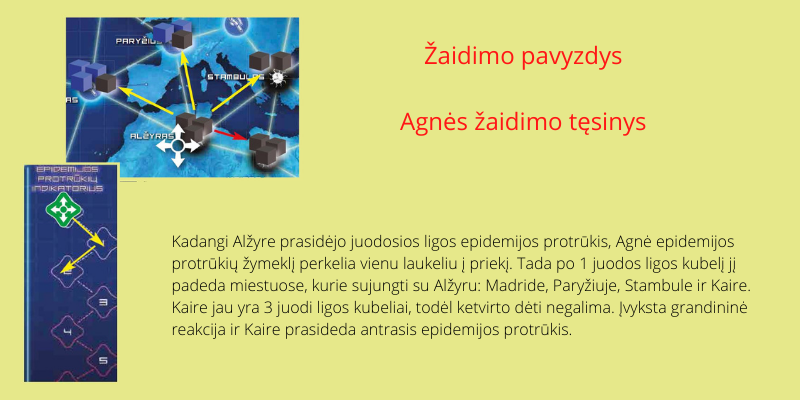

End of turn (the whole Pandemic game is not finished yet)
After the infection is spread and the used infection cards are placed in the used infection card pile, the turn ends. The next player on the left then plays.
Event cards
Event cards can be used at any time, but also during another player's turn. The most important thing is not to interfere with the execution of the card you have just drawn! The use of this card is not an action, so it does not require the use of 1 action point. It is up to the player holding the card to decide how to use it.
For example, in "Spreading the Infection", the first infection card taken triggers an epidemic outbreak. At this point, the event card cannot be used to stop the outbreak. But the use of the event card "Air Transport" to move a quarantine specialist (thus protecting other cities) is possible after all actions related to this outbreak have been carried out. After the event card has been used, the second epidemic card can be used.
End of game
The Pandemic game is won by inventing vaccines for all 4 diseases. It is not necessary to cure all diseases, it is important to invent vaccines. Players win even if there are no disease cubes left on the game board.
Pandemic is over and the team loses if:
- In the outbreak indicator, the outbreak marker reaches the last field;
- A player is supposed to place a set number of disease cubes on the board, but there are simply no more;
- the player has to pick up two playing cards, but they are missing or out of stock.
Pandemic has 7 special characters
Elsewhere in the game editions the number of character cards is no longer 7. New editions and expansions also include special event cards and additional pathogens.
Contingency planner
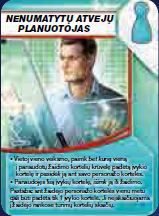
Instead of his one action, he can take any one event card placed in the discard pile. The card is placed on the character card. Only one event card can be placed on this card at a time. It does not count towards the number of cards in the player's hand.
When this event card is used, it is not placed in the discard pile but in the game box.
Operations Specialist

Instead of one action, it can:
Build a research station in the city where his figurine stands without using a city card;
Using any city card, move your piece from a city with a research station to any other city once during your turn.
When a dispatcher moves an operations manager, the special skills of the operations specialist can only be used during the move.
Dispatcher
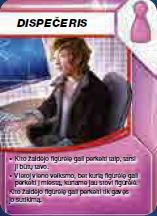
Instead of one action, it can:
if the owner agrees, move any piece to any other city where the piece is already located;
if its owner agrees, move any of the other player's pieces as if they were his. In this case, the dispatcher performs the action "Direct Flight" or "Charter Flight" and places one of his city cards in the discard pile of used playing cards. If the action is a "Charter Flight", then he shall place the card of the city where his piece is standing in the used card pile.
The Dispatcher can only move other players' pieces, but cannot perform other actions on them, such as "Curing a disease".
Quarantine Officer
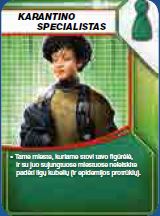
Disease cubes and epidemic outbreaks must not be placed in the town where the quarantine officer is based, or in any towns connected to it. The exception is the placement of cubes on cities during game preparation.
Investigator
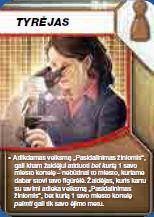
During any player's turn, he can perform the action "Share Knowledge". The Investigator can give (not take) any 1 of his City cards to another player standing in the same city - not necessarily the city where his piece is currently standing.
Medical
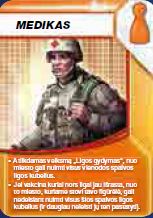
In the Disease Cure action, the medic can remove not 1 but all disease cubes of the same colour from a city. If a vaccine has already been invented for a disease, then he can remove all the disease cubes for that disease in the city where he is standing, not necessarily during his turn, and this action does not count as an action. A medic can automatically remove disease cubes when he is moved to a city by a dispatcher or when he is moved during an "Air Transport" event. There is no need to wait for your move.
Players cannot place disease cubes (epidemic outbreaks) for which a vaccine has already been invented in the city where the medic is standing.
Researcher
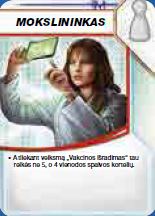
The Scientist needs only 4 cards for the action "Inventing a Vaccine" instead of 5.
Pandemic has a number of rules. It is important to note the following:
- If you take an epidemic card, you cannot replace it with another card;
- A vaccine can be invented on any research station. The colour of the city does not have to match the colour of the cubes of the disease for which the vaccine is to be invented. More about the invention of a vaccine;
- If you and another player are both standing on the same city, you can take a city card from that player during your turn. For more information on picking up your city card;
- During your turn, you can only take a city card from an investigator if you are both in the same city. More about researcher privileges;
- The limit on the maximum number of cards in a hand starts as soon as a card is received from another player. For more information on maximum number of cards.
